Summary
- This guide offers a 30-day social media plan to help you create high-quality content, engage your audience and achieve business goals. It includes tasks to complete each week.
- Improve how you define goals, understand your audience, build a content calendar and measure success.
- Learn how to create content that resonates with your target audience through content brainstorming, resource allocation and optimization techniques to maximize reach and engagement.
- Follow this plan to develop a successful social media strategy that drives real business results.
Your goal is to deliver high-quality content that engages your audience, establishes brand trust and drives business value. But how can you develop a social presence that ultimately impacts your business’ bottom line?
A social media plan is a comprehensive blueprint for your social media management strategy to help you do just that. With the right plan in place, you can set realistic and achievable goals that align with the overarching needs of your business. You’ll also learn how to integrate emerging trends and best practices into your strategy.
Use this social media plan (and template!) to re-invent your approach to social media management. By completing just one task a day over the next 30 days, you can craft an approach that transforms your online presence and engages your audience like never before.
What is a social media plan template?
A social media plan template is a resource that helps people and businesses organize and manage their social media efforts. It includes sections for setting goals, knowing your audience, planning content, scheduling posts and tracking results.
There are many ways you can approach a social media template, but one thing is true across the board—updating your social media strategy is no quick feat. That’s why our template is broken down into a 30-day process. Focusing on one task a day provides steady progress while preventing overwhelm.
Get the template
Week 1: Establish your goals and define your metrics
Day 1: Establish goals for social
Establishing clear social media goals is the first step toward transforming your strategy. Determine exactly what you want social to achieve. And make sure your social goals align to broader marketing and organizational goals.
Here are several examples of goals you might consider:
- Drive website traffic
- Raise brand awareness
- Boost brand engagement
- Generate new leads
- Nurture leads
- Build a community around your business
- Establish authority and industry expertise
- Improve customer support
- Shift brand sentiment
The objective here is to give purpose to your social efforts. Once you’ve established your social goals, the content you produce and share should continually support those goals.
There are several methods to help you write out specific social media goals, including the Objectives and Key Results (OKR) method.
The OKR method asks you to set a broad objective statement and list out key results that describe what successfully achieving that objective looks like. Here’s an example of a broad objective statement supported by clear result metrics that define meeting the objective.

According to this example, if your objective is to boost brand engagement, you must increase the number of likes, shares, mentions and comments by 20% by the end of the fourth quarter.
Day 2: Define your success metrics
How do you define the success of your social efforts? Decide which metrics will provide the right data to determine whether social supports your business goals.
As you identify your success metrics (e.g. organic mentions, share of voice or conversions), set clear standards for your social campaigns to understand when you achieve success. If you are tracking audience engagement, what exactly do you consider successful engagement rates for your social content?
Depending on the type of content you produce, where you share it and the goals you set for your social marketing efforts, the metrics you track will change.
If you’re at a loss for the metrics your team should set, use the Social Media Metrics Map to assess options for owned, earned and paid social.
Day 3: List out your challenges
The task is simple: Make a list of the challenges you face when it comes to social media marketing. Think of any barriers that keep your social content from making its biggest impact.
As you list your challenges, write simple explanations of how these barriers impact your marketing efforts or overall business success. Here are a couple of examples to help you get started.
Challenge 1: Although we consistently post on social, we aren’t achieving ideal engagement levels.
Challenge 2: We have seen a dramatic drop in our social content’s organic reach.
Day 4: Brainstorm solutions
Round up your marketing team and brainstorm possible solutions to the challenges you previously listed.
Be sure to provide evidence to justify effective solutions so you’re prepared when the time comes to gather resources and advocate for your budget.
Solution to Challenge 1: We can use influencers to engage with our social content and drive conversation.
Justification: A recent Sprout Social Pulse Survey found that most marketers (68%) believe the greatest value influencers bring to brands is expanding their reach to new audiences. With loyal followings, influencers can boost engagement and keep relevant conversations going on social.
Solution to Challenge 2: We can invest in paid social media advertising to run highly targeted campaigns and reach the right people.
Justification: Almost half of consumers report they “find the perfect products” by seeing targeted ads. By 2025, social shopping is set to become a $1.2 trillion channel.
Day 5: Analyze the competition
If you’re running out of ideas, try running a social media competitive analysis. Be careful not to mimic your competitors’ content, but use your analysis to determine your brand’s unique positioning instead.
Your brand and its competitors have similar ideal customer personas, so focus on the type of content that resonates, both within your own social efforts and those of the competition.
Here are a few questions to consider as you analyze your competitor’s social marketing efforts:
- Which marketing channels are my competitors using and are they successful in those channels?
- What are my competitors talking about and are those topics generating high audience engagement?
- Are there areas within our social strategy where we are outperforming our competitors?
Social analytics solutions are an effective way to compare your efforts against your competitors. Using Sprout’s Analytics, you can directly benchmark your efforts against one or more competitors.
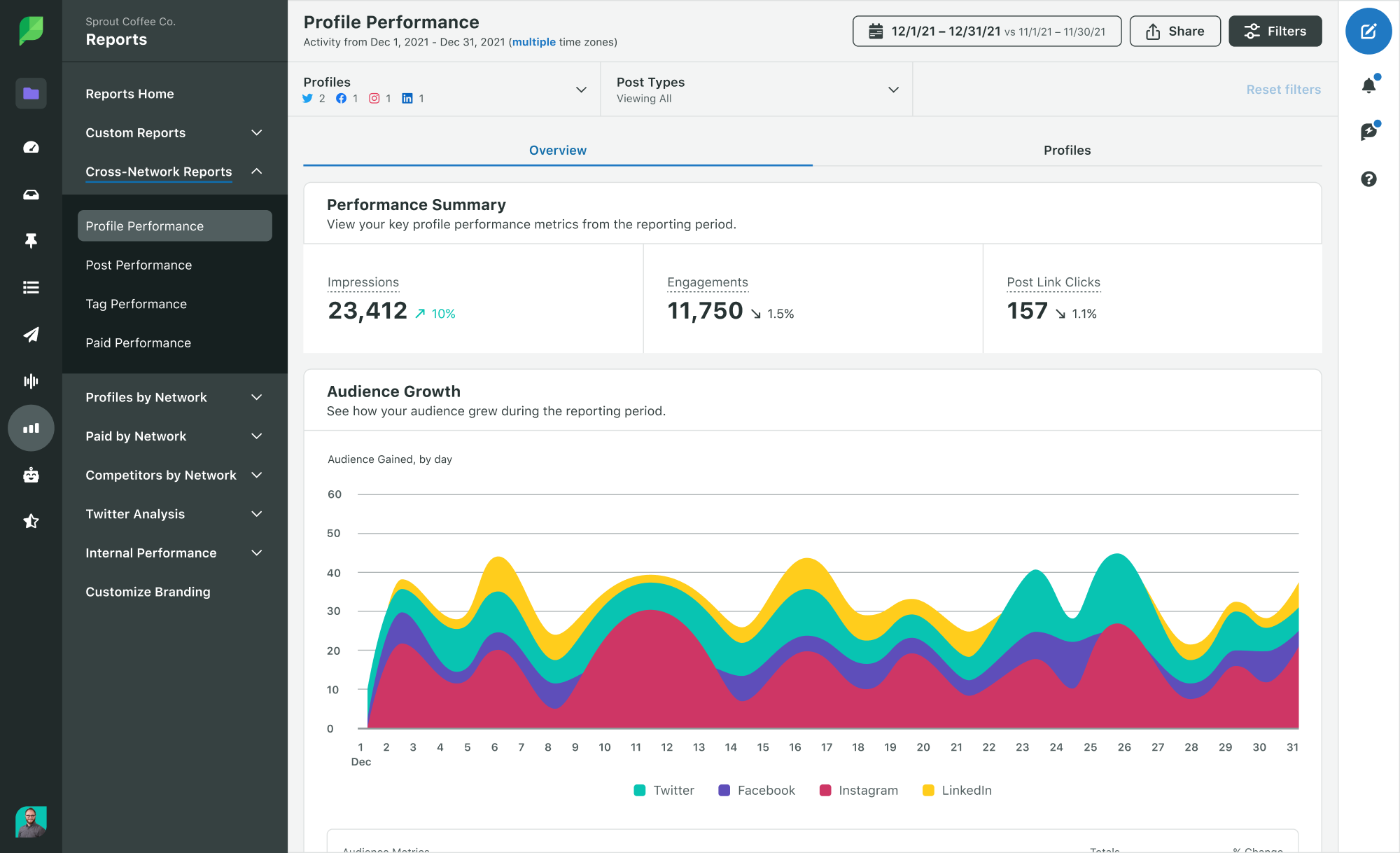
You can pinpoint days when competitors experienced peak engagement and dive deeper into what content was shared on those days to understand what resonates most with target audiences.
Start your free Sprout trial
Week 2: Optimize your profiles and brand voice on social media
Day 6: Determine your strengths and weaknesses
Take a deep dive into your social strategy and determine where you are successful and where there’s room for growth.
Conduct a survey among your marketing, sales, customer service and product teams to gauge where they see areas of success or room for improvement.
For each criteria regarding your social marketing strategy, determine whether it’s one of your strengths or weaknesses. This will help identify what you should focus on over the next five weeks.
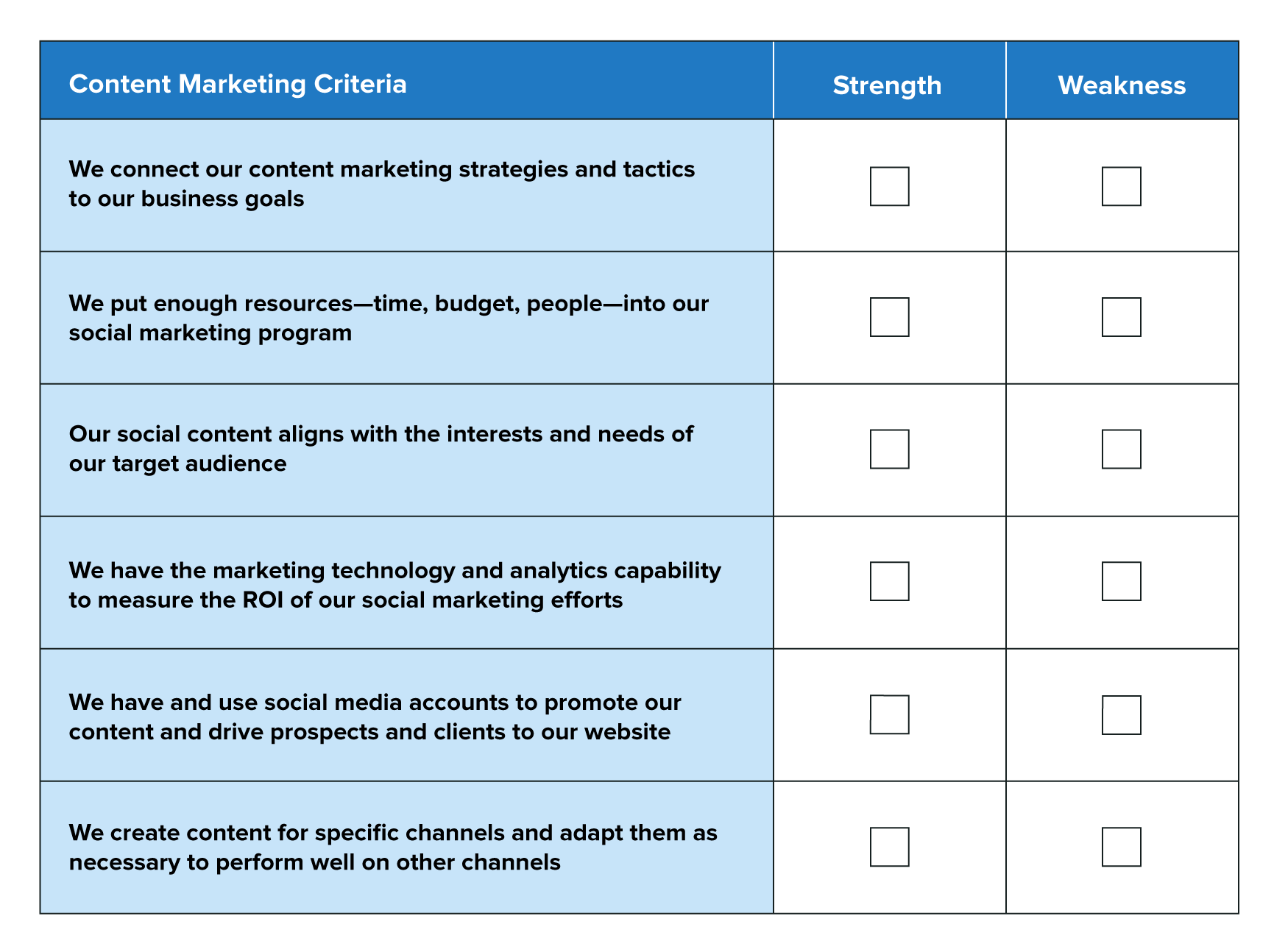
Day 7: Audit your content
Run a social media audit to identify your best-performing content and most popular channels. Take time to understand what’s working and why. Your metrics can help you identify which posts effectively cater to the interests of your audience.
If your posts aren’t engaging and resonating with your followers, your social media content strategy needs to shift. Use your audit to review the content you’ve shared and identify which posts had the biggest impact.
You can use Sprout’s Post Performance Report to parse through your most popular posts across platforms like Facebook, X (formerly known as Twitter), Instagram, TikTok, LinkedIn and Pinterest.

Day 8: Create a list of relevant keywords
Use social media listening tools to identify the keywords most often associated with your brand. These keywords can help your team throughout the content brainstorm and creation process.
Social listening can help you uncover unique opportunities to tie trending conversations to your business and products. For example, we often see healthcare organizations using social listening to better understand trending conversations and industry topics. A hospital system can create a “back to school” social listening query at the end of the summer and learn parents near them are concerned about how this will impact the spread of the flu and other viruses.
This little nugget of insight can inspire social strategy, out-of-home advertising, internal resource distribution—the opportunities are endless.
Day 9: Determine your brand voice and social persona
When it comes to building a social audience, consistency is key. Creating a brand voice and identifying a persona will enable you to remain consistent across all of your social channels.
To develop a brand voice, first, understand your target audience and what resonates with them. Next, define your brand’s personality by deciding on a tone and style that reflects your values and appeals to your audience.
After you narrow in on your persona, choose three words that describe your brand, then explain what they mean for your brand and create dos and donts to guide content creation.
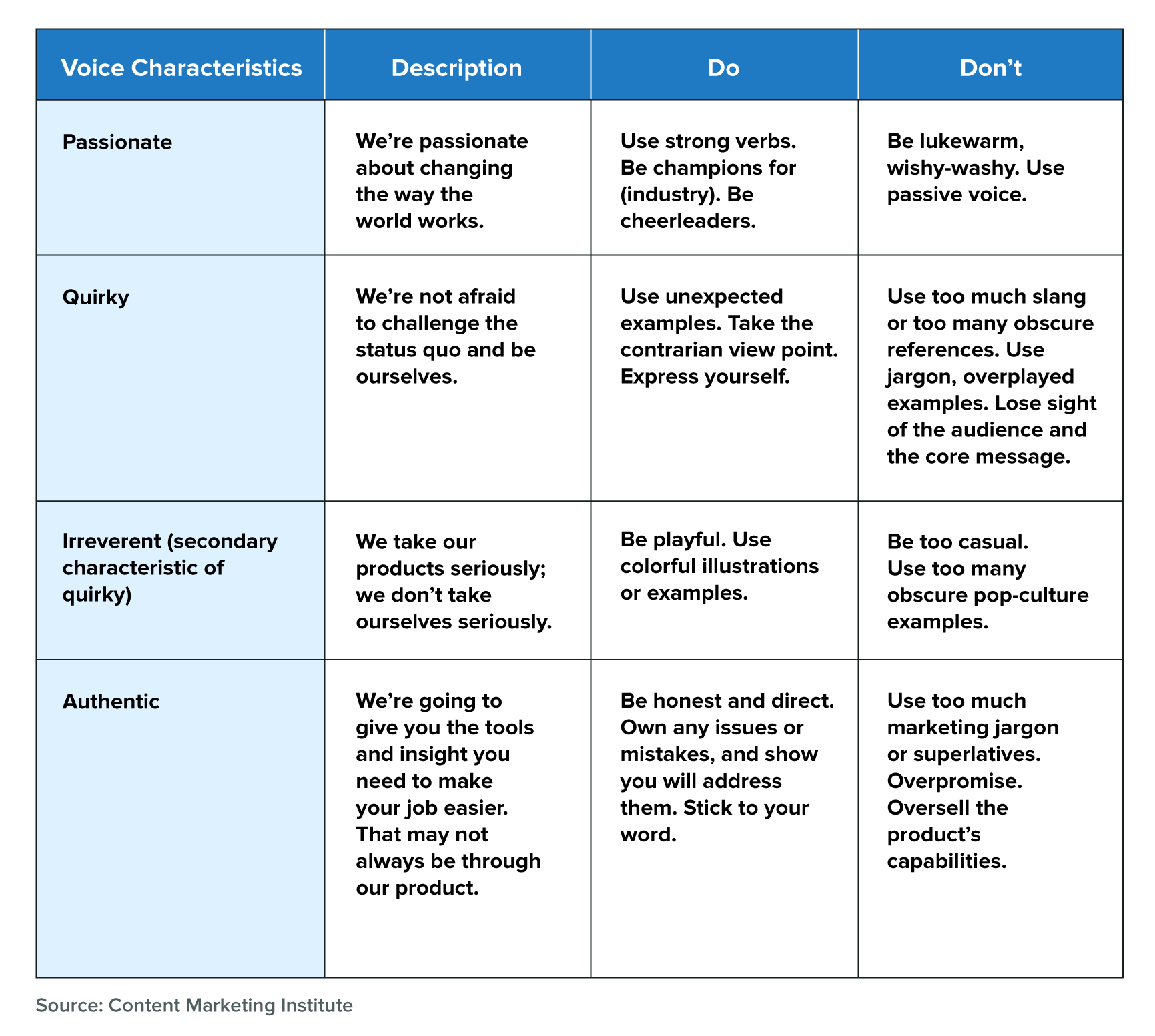
Day 10: Optimize your social profiles
While much of your time is spent planning and creating content, the information included on your profiles is vital to the success of your social marketing efforts.
After you’ve determined your brand’s persona, build out your profiles to align with your voice.
At a quick glance, your profile should speak to your brand with relevant visuals and engaging copy. Here are a few tactics to optimize your social profiles.
1. Use a consistent profile picture
If you own multiple social channels for your business, it’s important that your profile picture is consistent across every channel. Most businesses will use their company logo or variations of their logo that have been designed specifically for their social accounts. Staying consistent across your profiles will increase opportunities for brand recognition.
2. Complete every section of your profile
If there is a field for information, take advantage of the opportunity to tell your brand’s story. In creative and succinct ways, you should be able to describe what your business does, the offerings you can provide and how you add value to the lives of your customers.
3. Add keywords to boost SEO
On Day 8, you compiled a list of keywords relevant to your industry, brand and its offerings. Use these strategic keywords in every section of your profile to boost SEO. They should appear in your bio copy, in photo names, interests and experiences.
Week 3: Find and listen to your community to better understand your industry
Day 11: Develop your buyer persona
Transforming your social marketing strategy may require you to either revisit your current buyer personas or create new ones from scratch.
Buyer personas help you better understand current and future customers, so you know exactly who you are marketing to and can create relevant content and offerings. Start by writing down everything you know about your target customer and research to fill in any gaps. For a robust buyer persona, try to capture the following information.
- Demographics
- Backstory
- Lifestyle
- Career
- Purchase behaviors
- Finances
- Goals, challenges, pain points
Day 12: Listen to your audience
Listening to your community can help you gain insight into the minds of your followers, so you can be more strategic in your social marketing efforts.
Using social media listening, you can learn a lot about your community (even when they’re not directly interacting with your brand) to inform a more effective strategy.

Social media listening tools provide an overview of conversations relevant to your search, paired with valuable sentiment analysis data that breaks down how your audience feels about a topic.
Here’s what you should listen for on social media:
- What your audience is talking about and what they share most often
- What your audience is saying about your brand, industry, products, services and competitors
- What your audience is sharing on forum-style platforms like Reddit or Quora
- How your audience engages with creators, trending topics and industry events
Day 13: Research industry trends and topics
To create relevant content and establish your brand as an authority on social, you must stay up to date with what’s happening in your industry.
Join conversations surrounding high-interest topics. Perform ongoing research to make sure the content you produce and share aligns with the current interests of your community. Here are a few resources to guide your research.
Newsletters
As social marketers, research is one of our most valuable skills. Instead of browsing aimlessly through content, rummaging through thousands of social profiles or running endless Google searches, an easy way to streamline research is to sign up for a solid mix of newsletters.
Newsletters provide insights into the state of the industry, changes in technology, updates to social networks and emerging trends and best practices.
Here are a few newsletters that social media marketers should add to their resource list:
- Link in Bio features expert interviews from industry-leading social media managers. The newsletter shares actionable advice and relatable experiences to inspire their community.
- Social Media Today focuses on sharing original analyses of what’s happening in social media. Their content is platform-focused, providing social marketers with insights on how to adopt new features and where other brands are finding success.
- SocialMedia.org is a membership organization for leaders in the social media marketing space. Their weekly newsletter, The Shortlist, highlights member stories as they share what they’re working on and what they’re keeping an eye on in the space.
Webinars
Webinars can have a significant impact on social marketing strategies by generating new leads and prospects, nurturing existing relationships and demonstrating expertise in our industries. During webinars, many businesses will live-Tweet along with their users to answer questions and keep the online conversation going.
Webinars can also provide a way for us to learn, which can spark content ideas during our brainstorming sessions. Social Media Today provides a wide variety of webinars specific to social marketers. You can register for upcoming webinars or watch from their library of on-demand sessions.

Forums
Forums give marketers an effective way to identify the topics that spur the most conversation online. Quora is a great resource to discover topics of interest, ask questions and engage in conversations relevant to your brand. As a brainstorming tool, forums can help social marketers build social content plans that address questions people are already asking.
Blogs
Adweek (and publications like Digiday and Marketing Land) present the anatomy of the latest, most creative campaigns out there, and also fill you in on the most recent news. The Mission (and Medium generally) is great to turn to for thought leadership and gauging the pulse of our industry and the visionaries in it.
Day 14: Connect with other departments
As you continue researching industry trends and topics as inspiration for your content, connect with other departments within your organization.
Social is no longer limited to marketing, with functions across the business weighing in on strategy. But as a more diverse set of stakeholders gets involved, core social teams will need to adapt. Figuring out who owns what, and which proficiencies are needed across teams, has to be addressed as social strategies become more sophisticated.

For example, try speaking with members of your sales team: they’re often the first points of contact for consumers, and they can provide insight into customers’ needs, challenges and successes. This insight can help generate content that addresses these needs or highlights successes.
Your human resources team can also provide insight into ongoing employer brand initiatives. Collaborate with HR to investigate how employees and potential hires are engaging with your brand on social. Their understanding of your workforce can help you identify what content is most effective for this important group of stakeholders.
A social media collaboration tool can help you streamline your efforts and manage cross-functional initiatives.
Day 15: Choose your content types
Start thinking about the types of content that’ll benefit your brand the most, while keeping your audience engaged.
Refer back to the buyer personas you created to determine if an image linking to a blog post would perform better than a Live Chat on X or an Instagram Live event. Consider the resources available to you to determine if you can create a high quality how-to video, or if you need to scale down your efforts and create an infographic using the same content.
For the best results, diversify your content to keep your audience interested. If you post the same type of content day after day or week after week, your audience will inevitably disengage.
Here’s a list of possible content types you can start incorporating into your social marketing strategies:
- Memes
- GIFs
- Infographics
- How-tos
- Polls
- Contests
- User-generated content
- Photo and video
- Live streaming
- Audio
Before you start searching for content to share on social, figure out what your audience actually likes. One way to do that is to look at past social media posts to see which were most successful.
Pull all of your unique social media analytics with a tool like Sprout Social, X Analytics or Facebook Insights. Below is an example of how to view your published posts with Sprout (available with a free, 30-day trial).
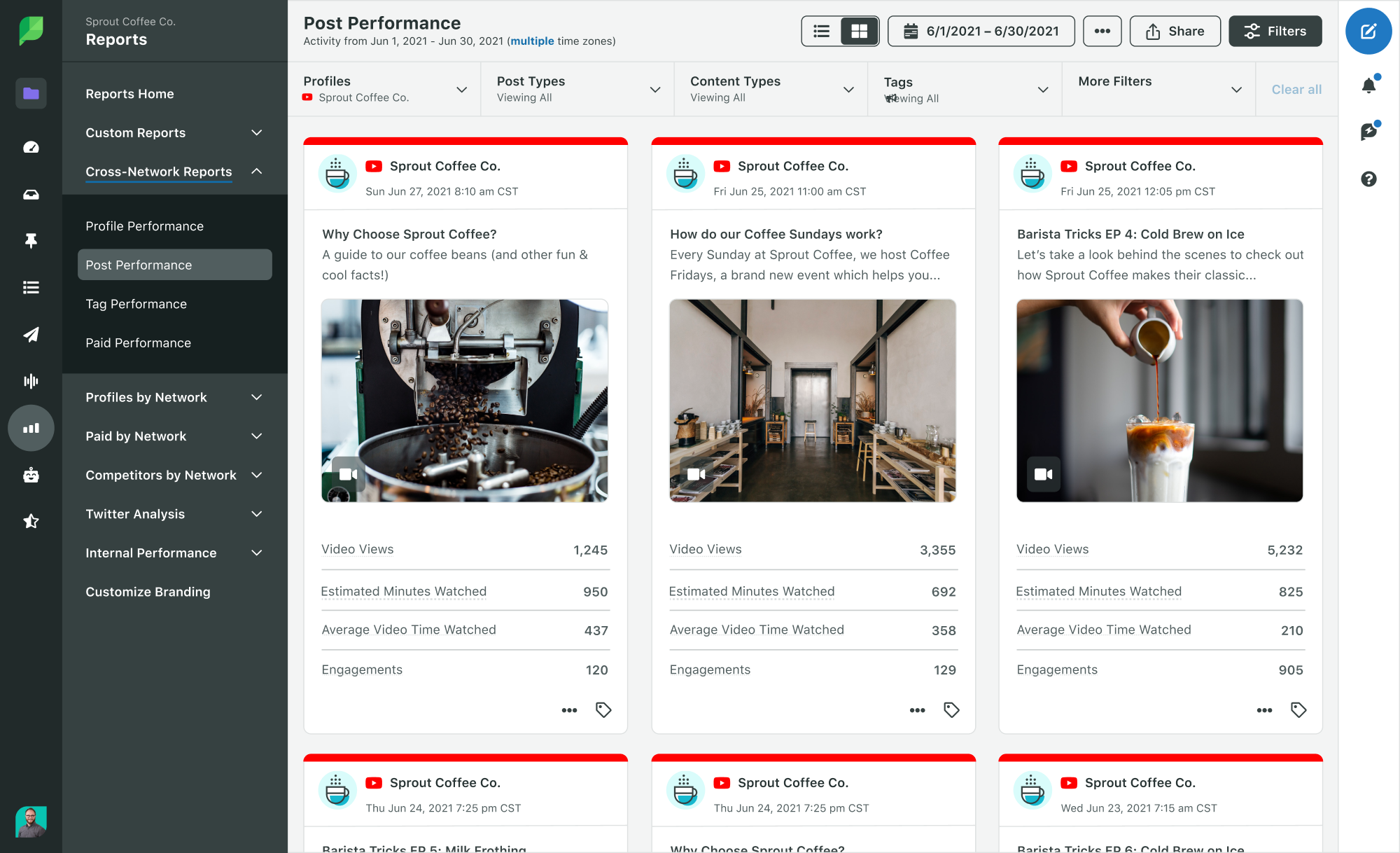
Make sure you sort your posts by the metric that’s most important to you, whether that’s clicks, responses or total reach. Once you have an idea of what kind of content works best, you can move onto the next step.
Week 4: Fill out your social content calendar to increase reach and engagement
Day 16: Develop a posting schedule
Your publishing cadence depends on a handful of factors, including your company, your audience, the campaign in question and the social networks being used. We cover this more in our guide on how often to post on social media, but here are some recommended cadences for each network:
- TikTok: 1-4 times per day
- Instagram: 1-2 times per day
- Facebook: 4-5 times per day
- LinkedIn: No more than 1 time per day
- X: 3-4 times per day
- Pinterest: No more than 1 time per day
There’s a good chance your post frequency will depend on the size, experience and authority of your social media team, so don’t feel like you have to send out less than stellar content to meet these guidelines.
Your brand’s analytics can help you determine your best posting frequency. You can use a tool like Sprout to see how often you post on each social network, then compare that to how much engagement you received over that same time period.
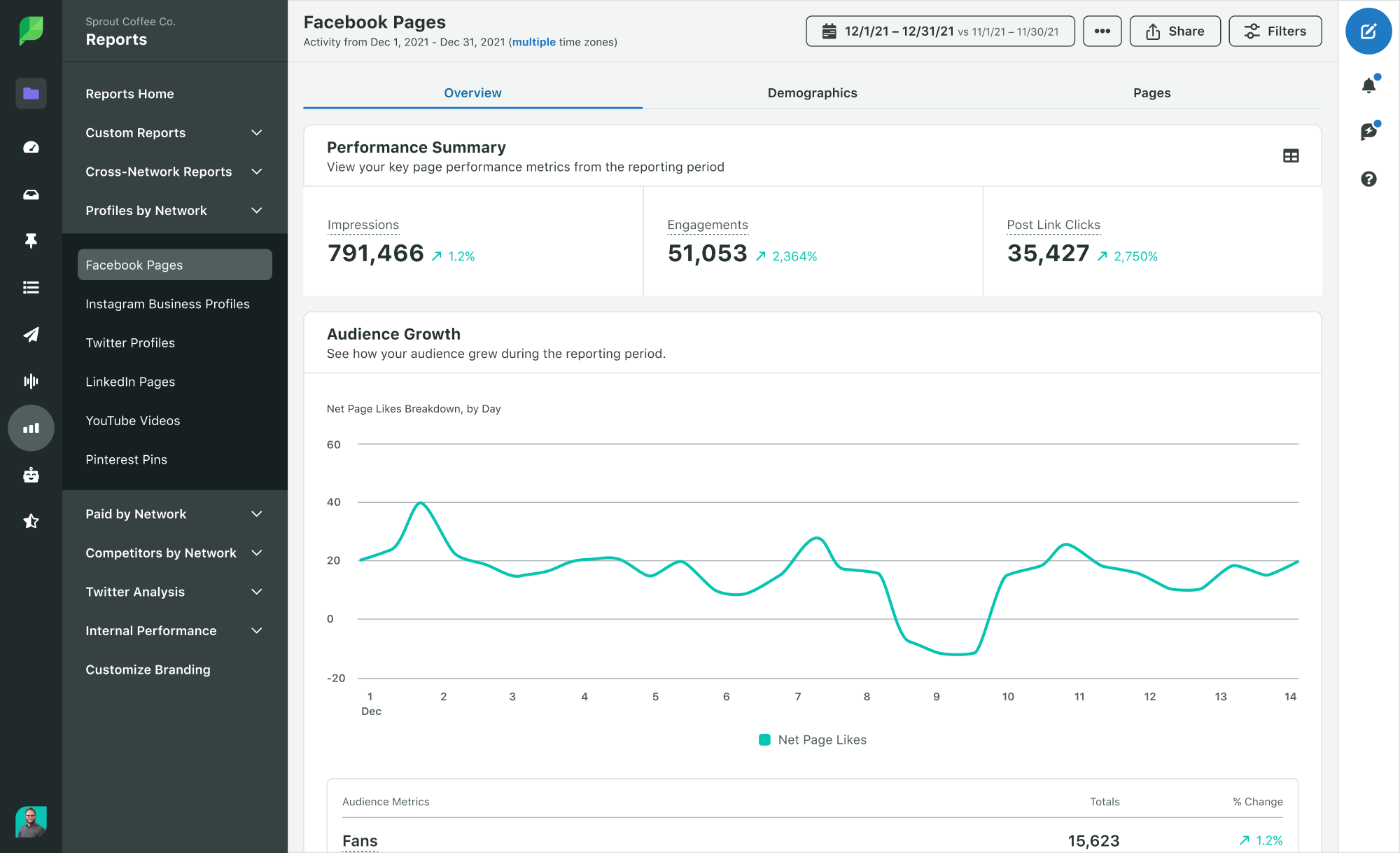
Look for trends between publishing rate and engagement. The screenshots above are from our Facebook Page Report, but you can do the same for Twitter, Instagram and LinkedIn posts as well.
Day 17: Brainstorm content ideas
Now’s the time to gather your inspiration and plan out content you know will resonate with your audience. The key to effective brainstorming is to put yourself in the mindset that inspiration can come from anywhere.
Think of what your business does well and how you can turn that into an engaging content piece. Look through some of your older content and see if you can repurpose or reformat it for a different channel.
Based on the conversations you’ve discovered are popular among your audience, how can you contribute to those conversations with fresh content? Here are some of 2024’s most popular content types.
Video
About 42% of consumers want brands to publish more short-form video, while 24% are looking for live video and 14% want long-form video. Even if you don’t have the budget to hire a videographer, don’t rule this medium out. Tools like Canva and Biteable have democratized the creation process. Anyone on your team can make professional, on-brand videos, even while working remote.
Images and text-based posts
In the era of video, images and static posts still pack a punch with today’s social users. In fact, 59% of marketers said they created more static images in 2023 compared to 2022. From TikTok to Instagram carousels, these posts are key pieces of leading content strategies.
User-generated content
Marketers have been able to amplify user-generated content to increase brand awareness, promote products and services and use the digital word-of-mouth concept to build brand trust and increase sales.
Day 18: Gather resources
Once you’ve determined the types of content best suited for your business and have decided on a publishing cadence, start gathering your resources.
Think back to the types of content you decided to incorporate into your social strategy and what resources you need to bring them to life. Here are several questions for you to consider as you start collecting your resources.
- Have you decided on the type of creative assets you’ll use and how you’ll store them?
- Who within the company needs to be involved to create this specific content piece?
- Do you need any sort of creative support for visual elements?
- Do you already own content (guides, e-books, blog posts) that can easily be repurposed for social?
Day 19: Draft your social media plan calendar and create your content
It’s time to get to work. Start the content creation process and set reasonable timelines for project completion.
Be sure to build social content that speaks to your customer personas, stays true to your brand voice and can easily fit within the posting schedule you’ve established.
Day 20: Optimize your content
During the creation process, it’s essential for you to optimize your content so our efforts don’t go unnoticed in consumers’ crowded social feeds. Every net-new content piece you create should be able to be repurposed for another use down the line.
Consider your video strategy. A video can be broken down into short clips, quote graphics, still images and more. Think through your options while creating content so you can fill out your social calendar with less effort going forward.
Here are a few additional tactics to optimize your social content to maximize reach and increase engagement:
Week 5: Supplement and boost your social media content calendar for the best results
Day 21: Create a call to action
Not all of the content you share on social needs to encourage customers to take action. You may even find that some of your most popular posts are those that simply showcase your brand personality or provide a good laugh for your audience.
Take The Sill, for example. Their TikTok videos provide their community with tips for caring for plants with a twist of humor that feels authentic to their brand. They go beyond standard product content, showcasing their brand in fun and creative ways that align with platform trends.
If the primary goal of your social marketing is to generate new leads and guide people into your sales funnel, you need to give your audience a clear next step. Include direct calls to action (CTAs) on the posts you’re using to drive action.
For copy inspiration, check out this article on effective social CTA phrases.
Day 22: Connect to more resources
By connecting your audience to more resources (especially owned resources) you establish your brand as an authority in your space while inviting them to engage further. The more they learn about you and stay engaged with your brand, the more likely they are to convert.
At Sprout, we often share links to some of our favorite blog posts for our audience to learn more about social networks, best marketing practices and trending topics.
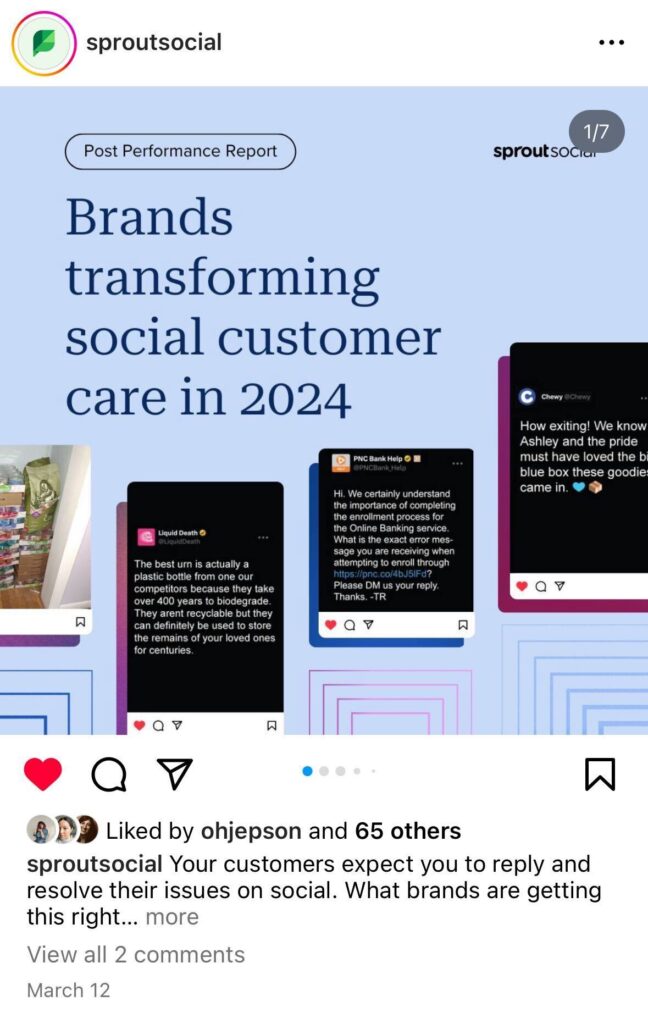
Day 23: Amplify your efforts
Once you’ve started promoting your content on social, think of ways you can amplify your messages to reach a larger audience.
Here’s a short list of methods to consider to extend the reach of your content:
Day 24: Invest in your best content
As you promote and amplify your content, you may quickly notice some types of content perform better than others in terms of engagement and conversion.
Extend the reach of these high-performing pieces through paid ads. You can target a highly specific audience, attract qualified traffic and leads and grow your customer base.
The algorithms for social networks like Facebook and Instagram now often favor paid content over organic content, making it increasingly important to invest in paid to give your content a fighting chance for discovery.
Which social media network you choose will depend on three important factors:
- Where your target customers are most concentrated
- Where your target customers are most accessible
- Where your target customers most actively engage with ads
Day 25: Engage with your audience
According to the 2023 Sprout Social Index™ Report, 76% of consumers say the most memorable thing a brand can do on social is respond to customers.
It’s important to engage with and respond to your audience. Engaging with your audience in a two-way dialogue builds brand trust and adds authenticity. As you watch your audience’s reaction to your content, you can also gain valuable insight into its effectiveness.
Read through the comments on your social posts and respond to questions and insightful comments. The comments section is a great tool for social marketers looking for feedback and can even inspire ideas for future content.
Week 6: Report on your social media results and celebrate your success
Day 26: Track your content
Content tracking is an effective way to track engagement and the movement of your content across social channels.
You can track all of your content with the Sprout Social Post Performance Report. Use the Post Performance Report to analyze published content down to the individual post and understand its performance with your audience.
Here’s an example of how to view your cross-channel post performance with Sprout (available with a free trial).

Day 27: Compare results to goals
Think back to the objectives you set at the beginning of these 30 days.
For example, if your objective was to boost brand engagement, you needed to increase the number of likes, shares, mentions and comments by 20% by the end of the fourth quarter.
Using a social media analytics tool, you can compare month-over-month engagement for all of your social profiles to determine if you are on track to meet your social marketing goals.
Day 28: Report out
Share the results of your social marketing efforts with your marketing team and leadership. If you’re new to reporting or need to brush up on best practices, here’s a suite of resources that can help you create a routine reporting system.
This is your opportunity to showcase the goals you’ve established and your progress toward them. You should use hard evidence, like the data you’ve gathered through listening and analytics, to report on the success of your social marketing efforts.
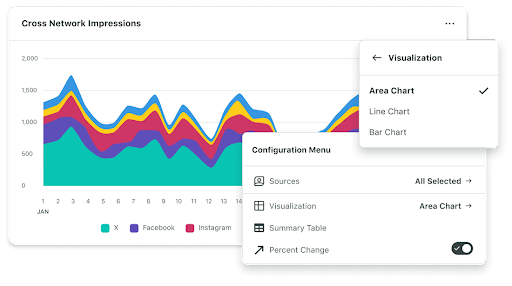
Depending on your goals, you may want to build custom reports that zero in on what matters to various stakeholders. With Sprout’s My Reports feature (available with our Premium Analytics) you can customize performance reports to meet your exact business needs. Users can create team-specific text annotations that provide rich context on strategic goals and big wins as they relate to the collaborator’s discipline.
Day 29: Revisit and readjust your strategy
The most savvy marketers know that marketing strategies are in constant flux. Revisit your strategy, revise your marketing goals and adapt your strategies based on the data you’ve collected.
Day 30: Celebrate your transformation
Congratulations, you’ve successfully made it through the 30-day social marketing transformation program.
Celebrate your new strategy and the effort you’ve made to enhance your social marketing.
Create your monthly social media plan with Sprout Social
This social media plan was created to help social marketers refine their strategies. Our goal is to provide you with actionable steps to transform your social marketing strategies to help you create content that’s purposeful, engaging and, ultimately, delivers real business results.
Keep in mind that transforming your social media strategic planning doesn’t end with these 30 days—continue to identify challenges to your social marketing strategy, analyze your competitors, discover ways to optimize your content and social profiles and remember to always revisit and adjust your strategies as needed.
Want to learn how Sprout Social’s features and solutions can help you create an even better social media plan? Start a free, 30-day trial to try Sprout for yourself.
Start a free trial

![30-Day Social Media Plan [Template] 30-Day Social Media Plan [Template]](https://virtual-coach.com/wp-content/uploads/2024/07/30-Day-Social-Media-Plan.jpg)

